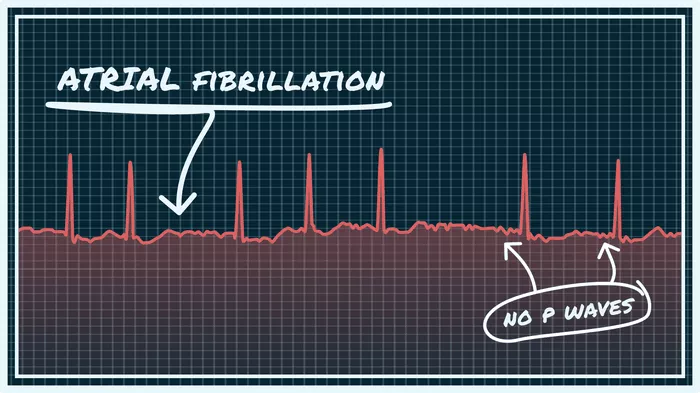Atrial Fibrillation (AFib) is a common heart condition that affects millions of people worldwide. It is characterized by irregular and often rapid heartbeats, which can lead to various complications if not managed properly. One aspect of managing AFib is considering the best sleeping position to minimize symptoms and promote better heart health. In this article, we will explore the relationship between sleeping positions and AFib, discuss the pros and cons of different sleeping positions, and provide tips for finding the most suitable position for individuals with AFib.
Understanding Atrial Fibrillation
Before delving into the specifics of sleeping positions, it’s important to have a basic understanding of Atrial Fibrillation. AFib occurs when the heart’s electrical signals are disrupted, causing the upper chambers of the heart (atria) to beat irregularly or rapidly. This irregular heartbeat can lead to symptoms such as palpitations, shortness of breath, fatigue, and chest pain.
Managing AFib often involves a combination of lifestyle changes, medication, and in some cases, medical procedures. One aspect of lifestyle management is optimizing sleep quality and quantity, as sleep plays a crucial role in overall heart health.
The Impact of Sleep Position on AFib
Sleeping position can influence the severity of AFib symptoms and overall heart health. While there is no one-size-fits-all approach, certain positions may be more beneficial or detrimental for individuals with AFib. The two primary sleeping positions to consider are sleeping on the left side (left lateral decubitus position) and sleeping on the right side (right lateral decubitus position).
Sleeping on the Left Side: Pros and Cons
Many healthcare providers recommend sleeping on the left side for individuals with AFib. This position offers several potential benefits:
1. Improved Heart Function: Sleeping on the left side may reduce the pressure on the heart and improve blood flow. This can be especially beneficial for individuals with AFib, as it may help regulate heart rhythm during sleep.
2. Reduced Acid Reflux: Left-side sleeping is often recommended for individuals with gastroesophageal reflux disease (GERD) due to its potential to reduce acid reflux. Since GERD can trigger AFib episodes in some individuals, managing reflux can indirectly benefit heart health.
3. Enhanced Lymphatic Drainage: The left side of the body is associated with better lymphatic drainage, which can help reduce swelling and improve circulation.
Despite these potential benefits, there are also considerations and drawbacks associated with sleeping on the left side for individuals with AFib:
1. Potential Discomfort: Some individuals may find sleeping on their left side uncomfortable, especially if they have pre-existing joint or back pain.
2. Increased Pressure on Organs: Sleeping on the left side can put pressure on organs such as the liver and lungs, which may be a concern for individuals with certain health conditions.
3. Individual Variability: Not everyone with AFib will experience the same benefits or drawbacks from sleeping on the left side. Individual preferences and comfort should also be taken into account.
Sleeping on the Right Side: Pros and Cons
While sleeping on the left side is often recommended, sleeping on the right side may also have potential benefits for individuals with AFib. Here are some pros and cons of the right-side sleeping position:
1. Reduced Heart Strain: Sleeping on the right side may alleviate strain on the heart, particularly for individuals with certain structural heart issues.
2. Comfort for Some Individuals: Some people find sleeping on their right side more comfortable, especially if they have specific health conditions or preferences.
3. Potential Discomfort and Pressure Points: Similar to left-side sleeping, sleeping on the right side may cause discomfort or put pressure on certain organs, depending on individual factors.
4. Potential Impact on Reflux: For individuals with GERD, sleeping on the right side may worsen acid reflux symptoms, which can indirectly affect AFib.
Finding the Best Sleeping Position for AFib
Choosing the optimal sleeping position for AFib involves considering individual factors, preferences, and potential benefits and drawbacks of each position. Here are some tips to help individuals with AFib find the most suitable sleeping position:
1. Consult with Healthcare Providers: It’s essential to consult with cardiologists or healthcare providers familiar with your medical history and AFib management. They can provide personalized recommendations based on your specific needs and health status.
2. Consider Comfort and Quality of Sleep: While certain positions may offer physiological benefits, it’s crucial to prioritize comfort and quality of sleep. Experiment with different positions to find one that allows you to sleep well without discomfort.
3. Use Pillows for Support: Pillows can be used strategically to support different parts of the body and improve comfort. For example, placing a pillow between the knees or under the abdomen can help align the spine and reduce pressure points.
4. Monitor Symptoms: Pay attention to how different sleeping positions impact your AFib symptoms. Keep a sleep journal to track any changes in symptoms based on your sleeping position.
5. Maintain a Healthy Sleep Environment: In addition to sleeping position, create a conducive sleep environment by ensuring your bedroom is dark, quiet, and at a comfortable temperature. Avoid caffeine and heavy meals close to bedtime.
6. Consider Other Lifestyle Factors: Managing AFib involves a holistic approach that includes regular exercise, a heart-healthy diet, stress management, and medication adherence. Incorporate these lifestyle factors to support overall heart health and improve AFib management.
Conclusion
The relationship between sleeping position and AFib is complex, and there is no one-size-fits-all answer. While sleeping on the left side is often recommended for individuals with AFib, individual preferences, comfort, and medical considerations play a significant role in determining the best sleeping position.
Consulting with healthcare providers, monitoring symptoms, experimenting with different positions, and prioritizing sleep quality are key strategies for finding the most suitable sleeping position for AFib management. By addressing sleep-related factors, individuals with AFib can improve their overall quality of life and promote better heart health.


